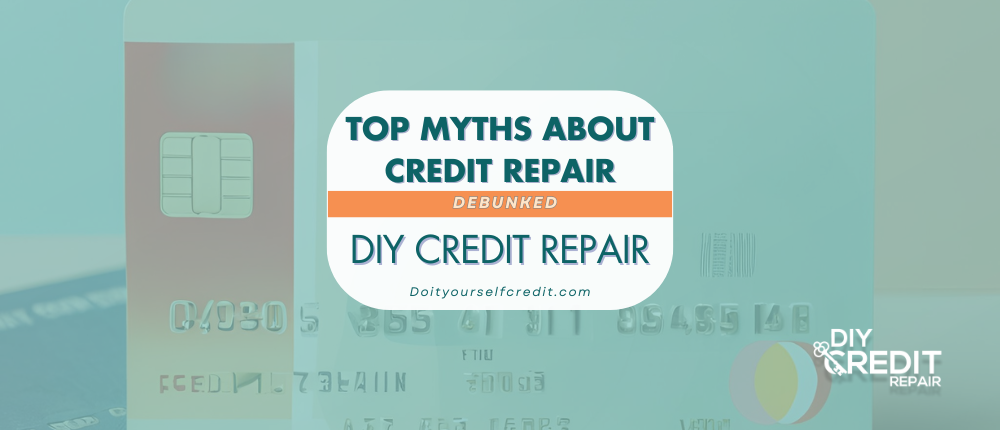
Navigating the world of credit can feel like walking through a minefield of misinformation. And when it comes to “credit repair,” the myths and misconceptions multiply! Too often, these misunderstandings stop people from taking action or, worse, lead them down the wrong path.
At DIY Credit Repair, we believe in clarity and empowerment. So, let’s shine a light on some of the most common credit repair myths and set the record straight. Knowledge is your best tool for building a healthier credit future!
Myth #1: Credit Repair is Illegal.
The Truth: Absolutely NOT! Legitimate credit repair is 100% legal and is based on your rights under federal laws like the Fair Credit Reporting Act (FCRA). The FCRA gives you the right to dispute any information on your credit report that you believe is inaccurate, incomplete, or unverifiable.
The confusion often arises from illegitimate companies that make false promises or use illegal tactics. The Credit Repair Organizations Act (CROA) was specifically enacted to protect consumers from these unethical practices. So, while scammy credit repair tactics are illegal, the act of repairing your own credit by ensuring accuracy and exercising your rights is perfectly lawful.
Myth #2: Credit Repair Offers Instant, Magical Fixes.
The Truth: If it sounds too good to be true, it probably is. There’s no magic wand or secret password that will instantly erase all your negative credit history. Credit bureaus and creditors have legally defined timelines (typically 30-45 days) to investigate disputes.
True credit improvement is a process. It takes time, patience, and consistent effort. While you might see some quick wins by removing clear errors, building a strong credit profile involves disputing inaccuracies, managing existing debt responsibly, and developing good financial habits over time. Beware of anyone promising overnight miracles!
Myth #3: You Can Remove ANY Negative Item from Your Credit Report.
The Truth: The goal of credit repair is to ensure your credit report is accurate and fair. You have the right to dispute and seek removal of items that are:
- Inaccurate: Wrong account numbers, incorrect balances, misspelled names, etc.
- Outdated: Most negative items have a reporting limit (e.g., 7 years for late payments, 10 years for bankruptcies).
- Unverifiable: If a creditor or collection agency cannot prove the debt is yours or that the information is accurate, it must be removed.
However, accurate, verifiable, and timely negative information will generally remain on your report until it naturally ages off. Credit repair isn’t about trying to fraudulently erase legitimate debts.
Myth #4: Credit Repair Companies Have “Secret Loopholes” the Average Person Can’t Access.
The Truth: While experienced professionals may have a deep understanding of consumer protection laws and dispute strategies, there are no “secret loopholes” exclusive to them. The laws and processes are available to everyone.
What legitimate credit repair companies offer is their expertise, time, and persistence. But with dedication and the right resources (like the tools and guides here at DIY Credit Repair!), you can learn to effectively advocate for yourself and manage your own credit repair journey.
Myth #5: Paying Off a Collection Account Will Automatically Remove It from Your Report.
The Truth: Unfortunately, not always. When you pay a collection account, its status will update to “paid collection” or “settled collection.” This is certainly better than “unpaid collection,” but the record of the collection itself (the fact it went to collections) typically remains on your report for up to seven years from the original delinquency date.
Sometimes, you can negotiate a “pay-for-delete” agreement before making a payment, where the collection agency agrees to remove the entire entry in exchange for payment. However, this isn’t guaranteed, and you must get such an agreement in writing before you pay.
Myth #6: Closing Old Credit Card Accounts Will Boost Your Score.
The Truth: This can often have the opposite effect! Two key factors in your credit score are your credit utilization ratio (how much credit you’re using compared to your total available credit) and the length of your credit history.
Closing an old account, especially one with a zero balance:
- Reduces your overall available credit, potentially increasing your utilization ratio.
- Can shorten your average age of accounts.
Both of these can negatively impact your score. Generally, it’s better to keep old accounts open and in good standing, even if you don’t use them regularly.
The Real Path to Better Credit
Effective, legitimate credit repair isn’t about quick fixes or shady tactics. It’s about:
- Understanding your rights.
- Regularly reviewing your credit reports for errors.
- Systematically disputing inaccuracies.
- Practicing good financial habits: paying bills on time, keeping credit card balances low, and avoiding unnecessary debt.
At DIY Credit Repair, we’re committed to providing you with the knowledge and tools you need to debunk the myths and take confident steps towards improving your credit. You’ve got this!
Disclaimer: This blog post is for informational purposes only and does not constitute legal or financial advice. If you have specific questions about your situation, please consult with a qualified professional.